|
 Dwight Peck's personal website Dwight Peck's personal website
A return to Italy after too long away
November 2022
You may not find this terribly rewarding unless you're included here, so this is a good time for casual and random browsers to turn back before they get too caught up in the sweep and majesty of the proceedings and can't let go.
We're not based in Europe anymore, and we've struggled through the covid-19 lockdowns like everyone else, so we haven't set foot in Italy since February 2019. Now we'll be making up for lost time with mad sightseeing, but missing the cats sorely all the while.
A tour of the Castel Sant'Angelo (aka Hadrian's Mausoleum)
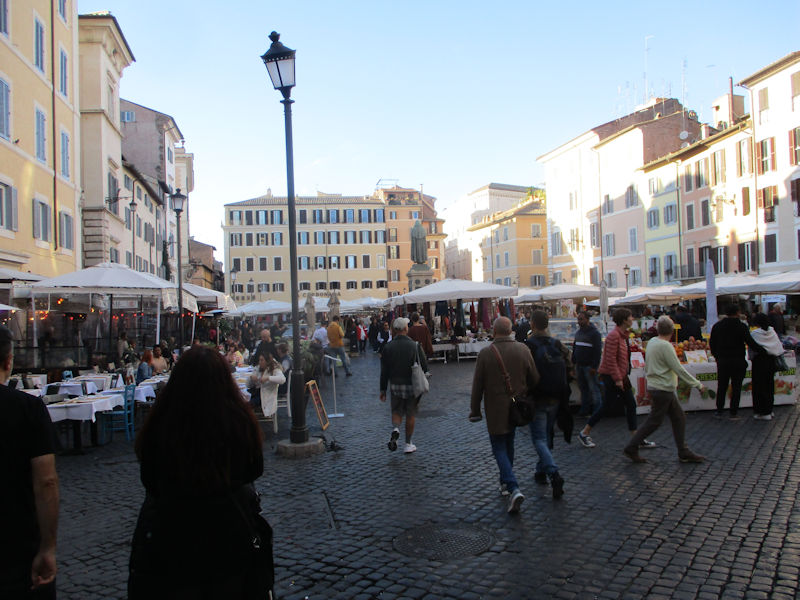
Here's the Campo de' Fiori, the public produce market since it was moved from the Piazza Navona in 1869. The 'Field of Flowers' was a meadow in the Middle Ages, but developed as a focus for artisan trades and residential palaces from the 15th century onward.

It's 100 meters long and 40m wide, and when the morning market is cleared up after noon the piazza is a pleasant gathering place through into the evenings.

It was also, in its time, a place for public executions, and this statue, set up in 1889, commemorates the execution by burning in February 1600 of Giordano Bruno, the philosopher, poet, mathematician, Dominican turned Calvinist, and heliocentric cosmologist, murdered as a heretic by the Papal Inquisition.
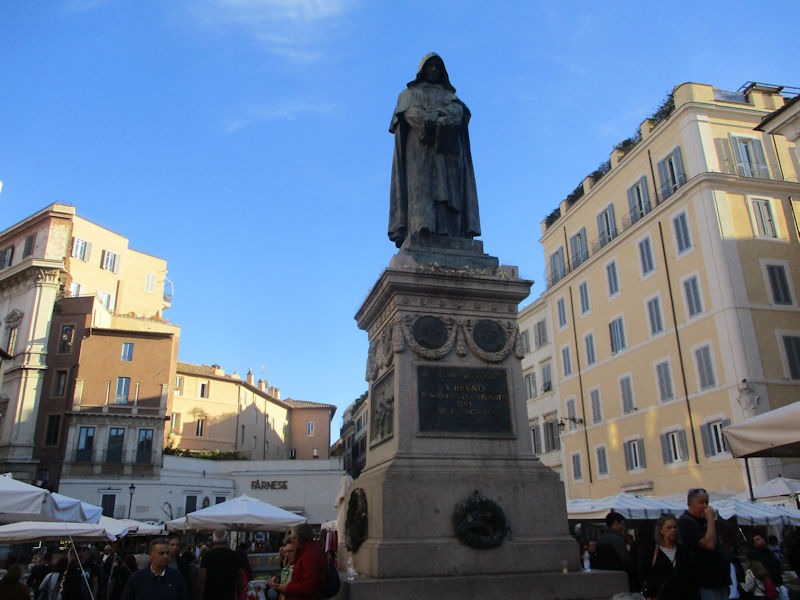
Bruno wrote some of this most important works whilst living in London, 1583-85, residing with the French ambassador there. The argument was made by John Bossy in 1991 that he was the mole passing French secrets to the English government under the name of 'Fagot', but in another book in 2001 he sort of changed his mind about that.

The Ponte Vittorio Emanuele II, inaugurated in 1911. We're proceeding towards the pedestrian Ponte Sant'Angelo just beyond.
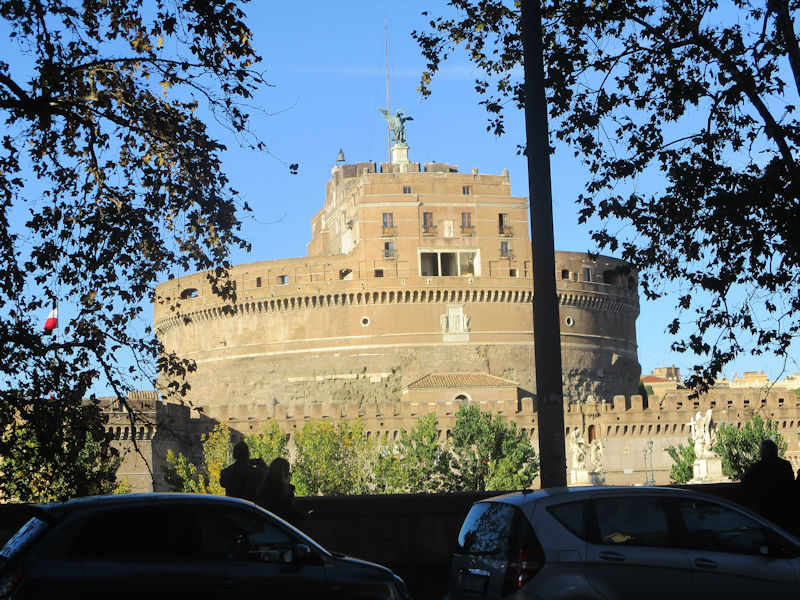
The Castel Sant'Angelo, aka the Roman Emperor Hadrian's Mausoleum, seen across the Tiber . . .
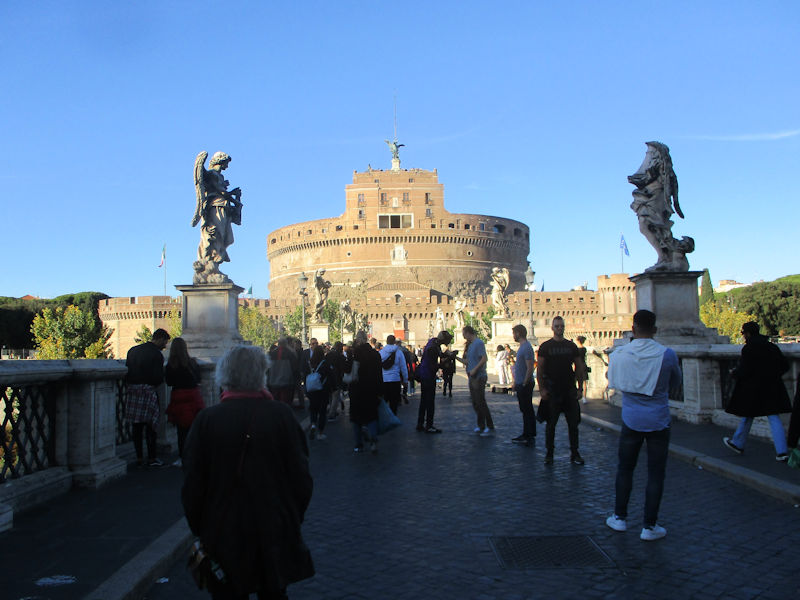
. . . and from the pedestrian Sant'Angelo Bridge
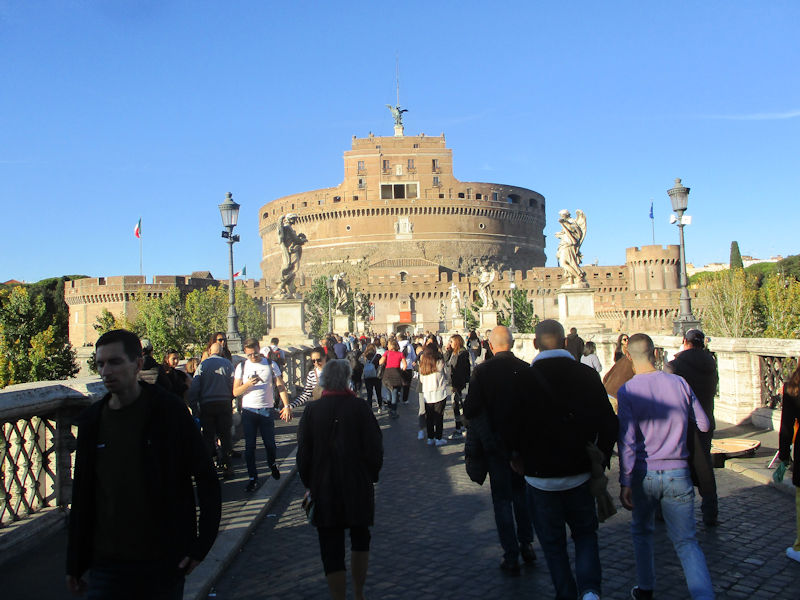
We're just passing by today, admiring its symmetries and casing the neighborhood. We'll return tomorrow morning for the full tour.
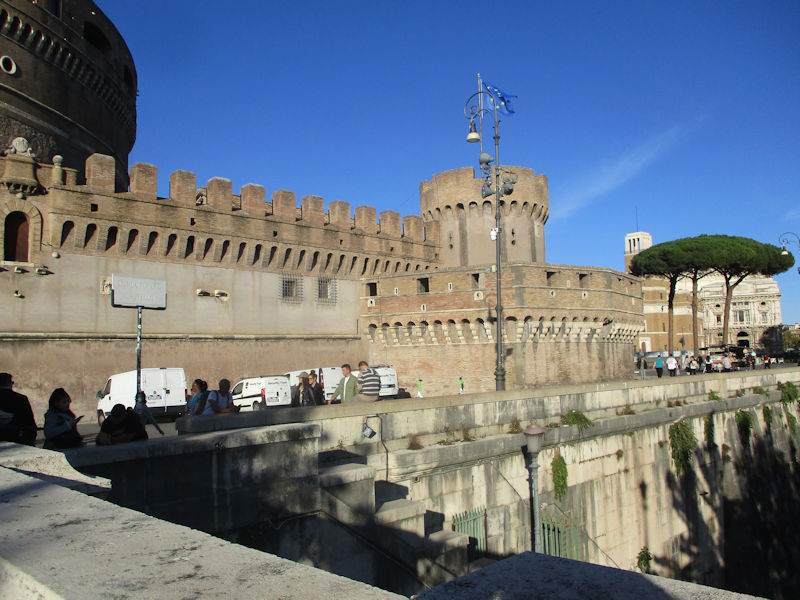
One of the four corner bastions, with artillery ports and a range of 'murder holes' all round. (Murder holes, or meurtrières, were placed over locations where attackers would have to pass underneath, so that a variety of terrible things or substances could be dumped on them. When they're located on the outside of fortification walls, as here, they're called 'machicolations'.)
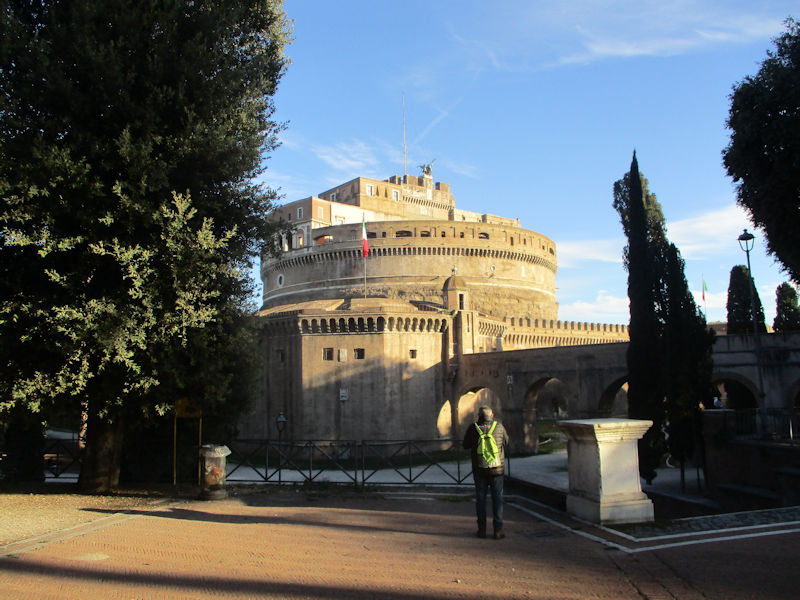
Round the other side of the castle, that's where the 800-meter Passetto di Borgo runs into the northwestern bastion of the four that surround the main drum of the fortification. ('Borgo' refers to the rione or center-city neighborhood between the castle and the Vatican.)
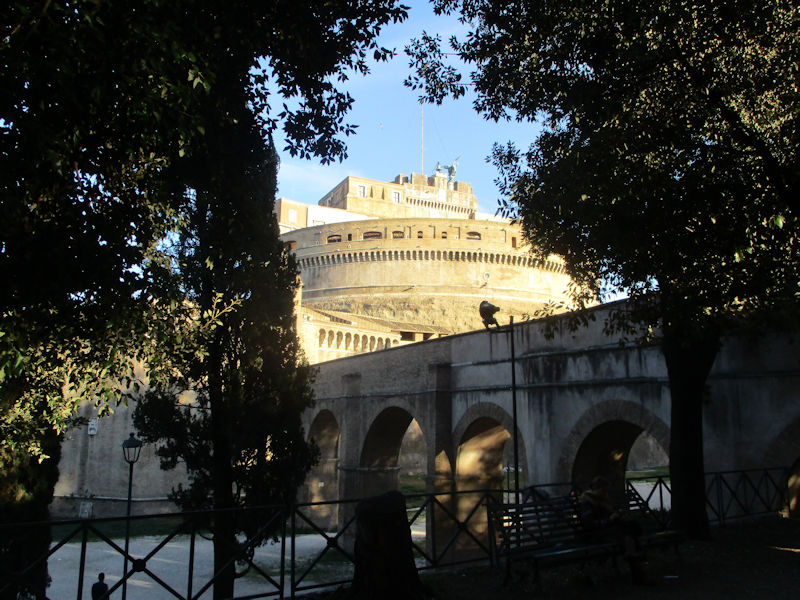
A passageway was created by Pope Leo V in the 9th century, intended to provide an escape route for the Pope, the Curia, and their friends, connecting the Vatican with the safety of the castle during the frequent occasions of mob insurgencies and battles amongst the city's warring noble families.
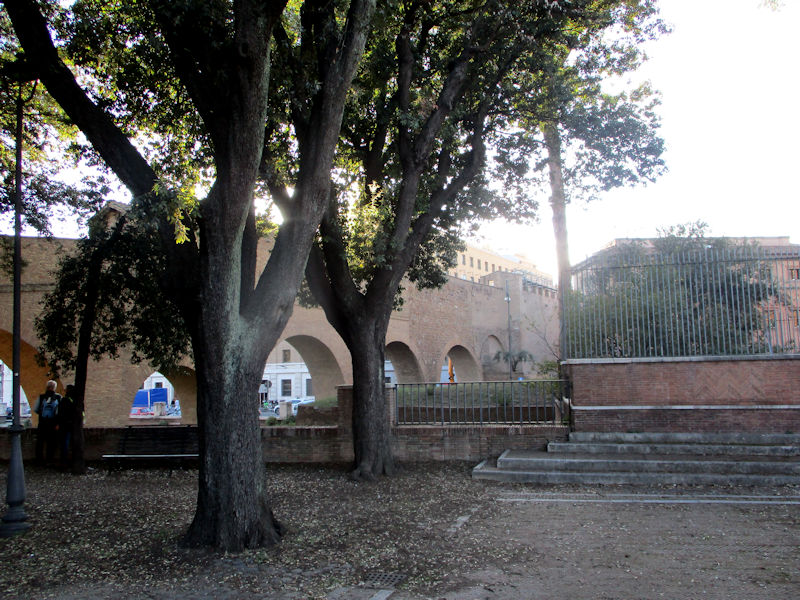
Pope Nicholas III Orsini renovated the passage in 1277 and linked it to St Peter's Basilica, at which time it acquired its present name. The Borgia Pope Alexander VI had the surrounding bastions built and linked to the Passetto in 1492, and just in time, too . . .
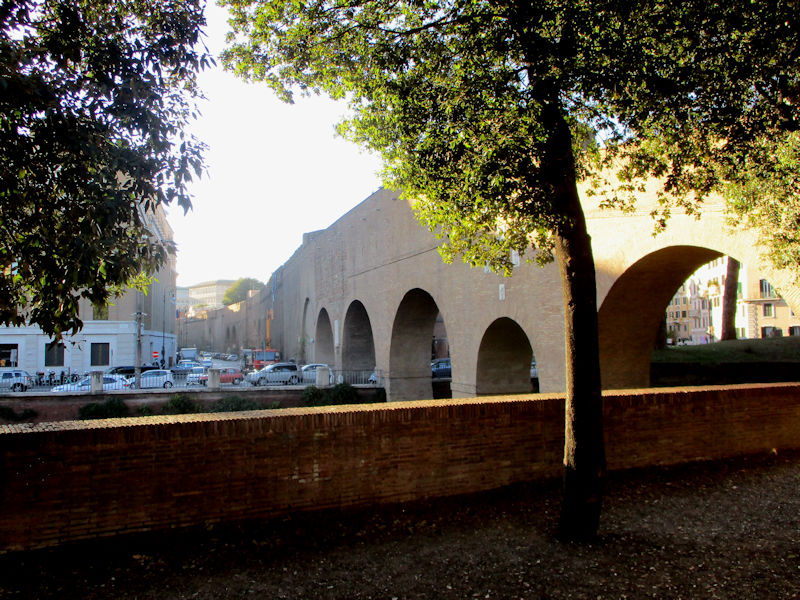
. . . because one of the two most urgent occasions when the passage came in handy occurred soon after: Alexander and his gang were able to scramble to the fortress in 1494 when the French king Charles VIII's invading army besieged the city until the pope agreed to give the French army free passage on its way to attack Naples (he agreed because Charles was holding his mistress Giulia Farnese hostage).
The second most notable occasion came in May 1527 when the unpaid and mutinous German and Spanish mercenary armies of the Emperor Charles V stormed into Rome and set about sacking the city horribly, not finally moving on until February 1528 when a plague struck the city -- during the attack, Pope Clement VII Medici and his entourage made it along the passage to find refuge, but he was kept prisoner in the Castel until six months later he escaped disguised as a peddler and made it to Orvieto.
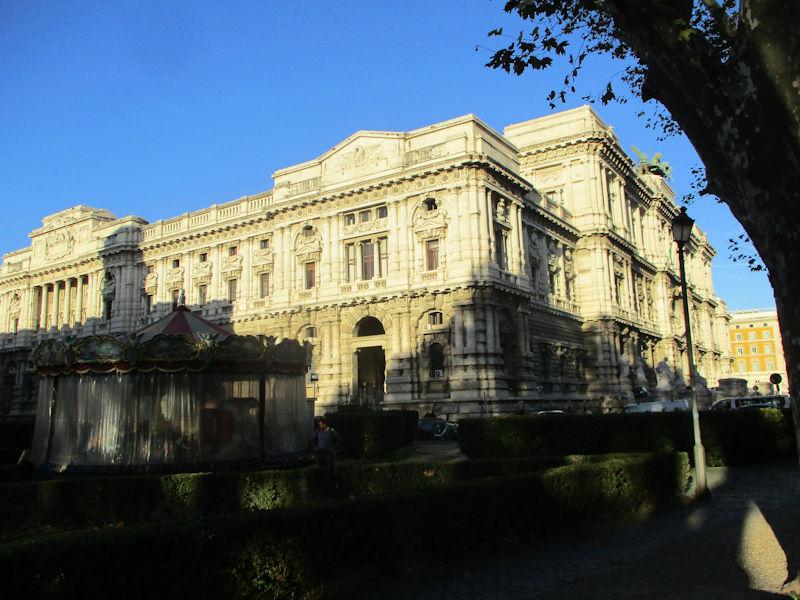
A few meters farther on up the river, this is the monumental national Corte di Cassazione, in effect the Supreme Court, in the Palace of Justice facing down onto the Piazza dei Tribunali and the Umberto I Bridge.
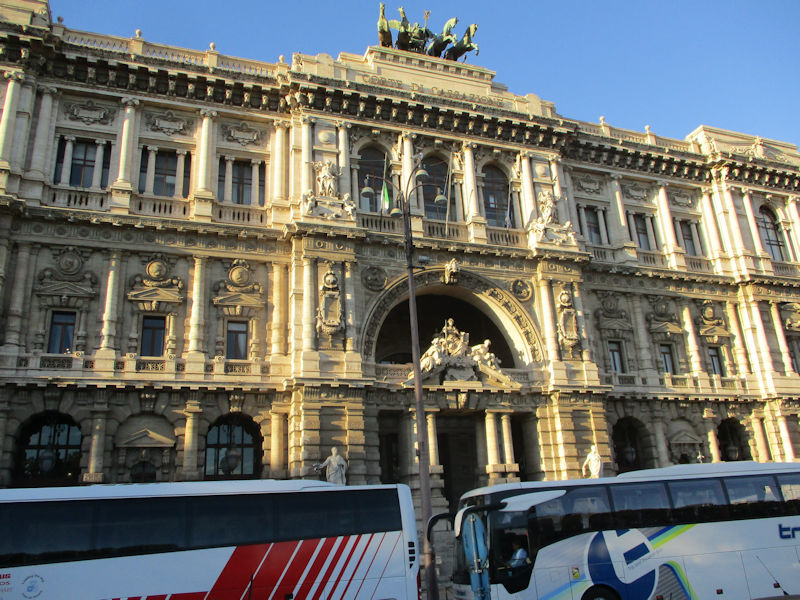
It was built between 1888 and 1910 and took so long that there were widespread suspicions of corruption, which though unproven (we're told) gave it the enduring nickname of Palazzaccio, or Bad Palace.
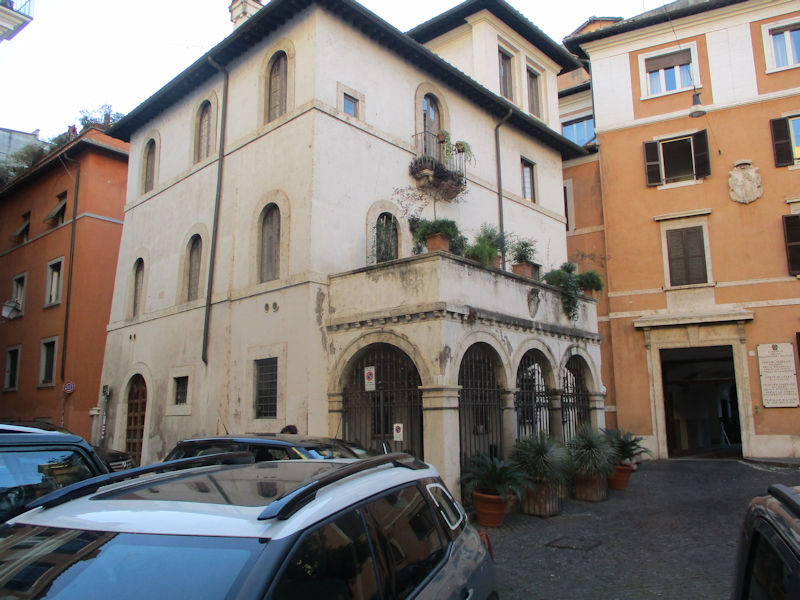
A little less of the triumphalist decoration on this little charmer nearby.
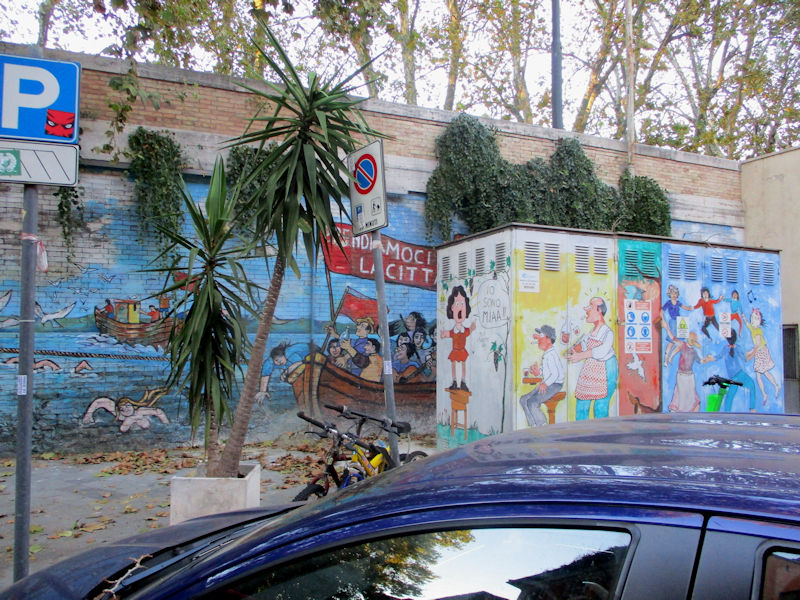
Street art

Just across the Ponte Sant'Angelo, on the Via dei Coronari, here's the Rome Duck Store ('The bath ducks, that have no precise function, do not play, do not perfume, do not contain things, they are just cute!'). They even carry a Star Wars line.
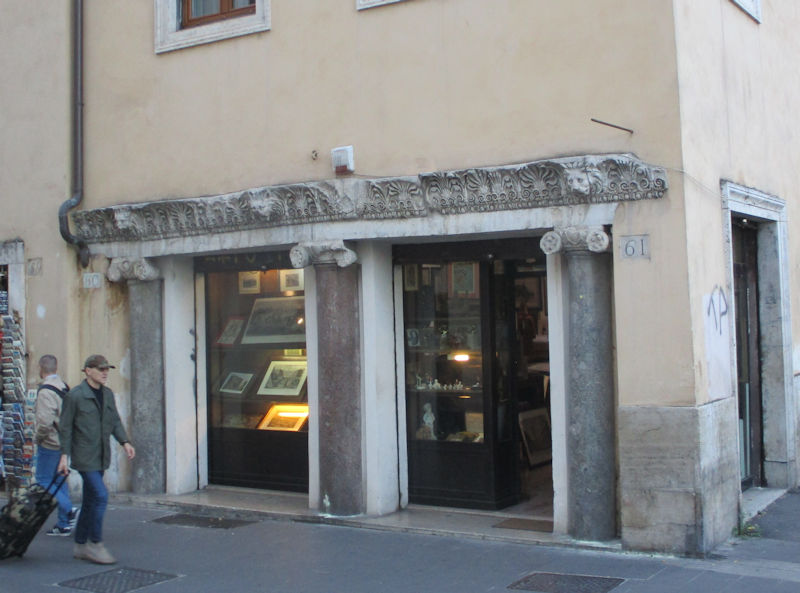
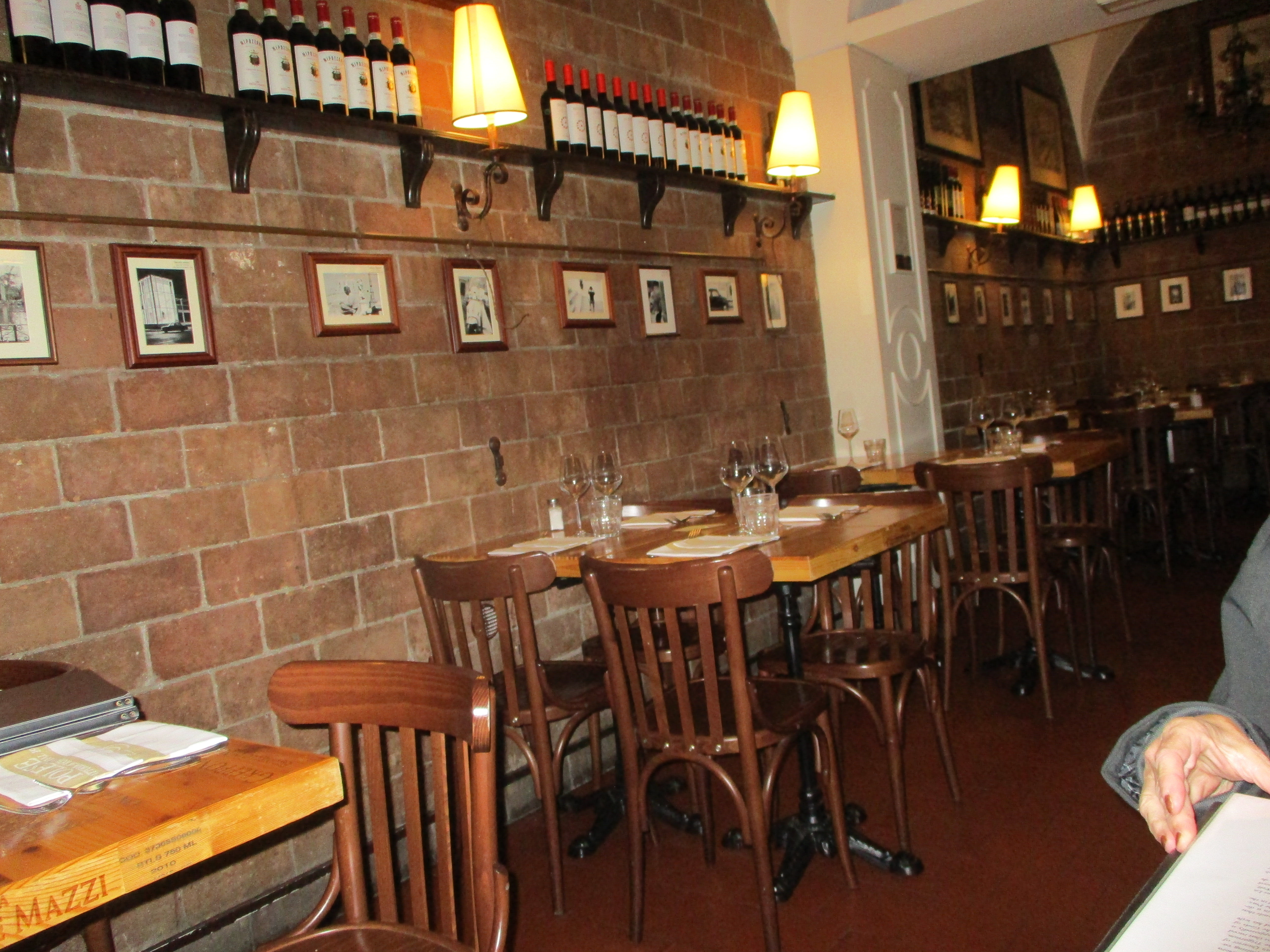
Dinner in the Trattoria Polese, 7 November, wonderful

And now, back to Hadrian's much transfigured Mausoleum

After a short time on line, we're admitted into the first set of walls, but we have to walk right the way all round the central drum . . .
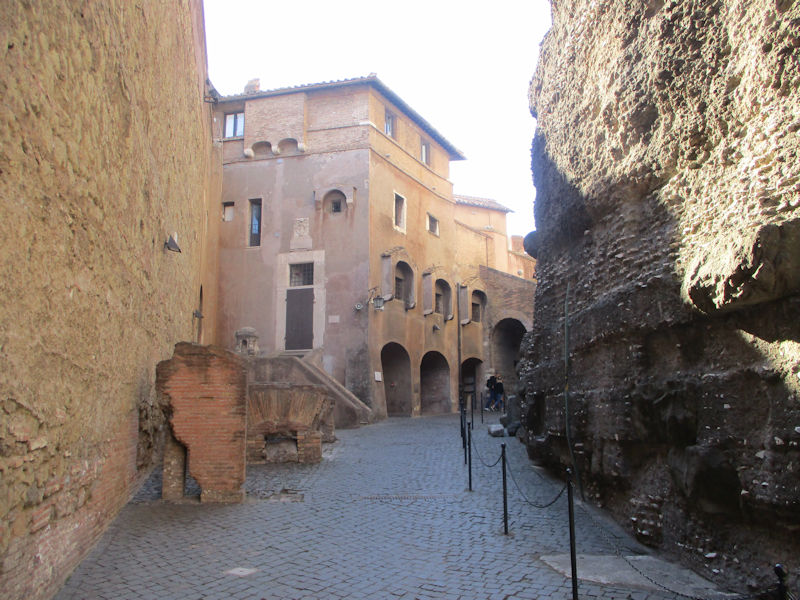
. . . before we can drop down into the centre of the thing, and then start up the helical rampway.
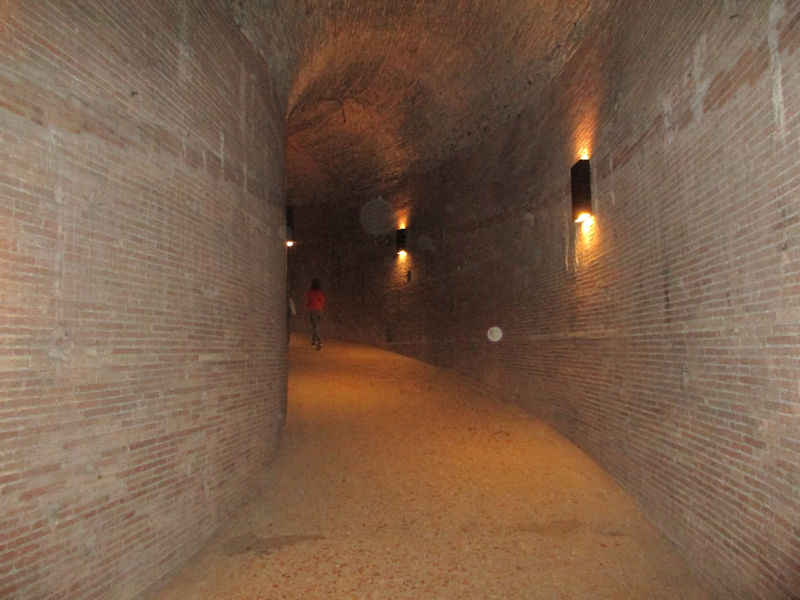
Like this. It's part of the original configuration though it was decorated back then and had a marble facing all the way up.
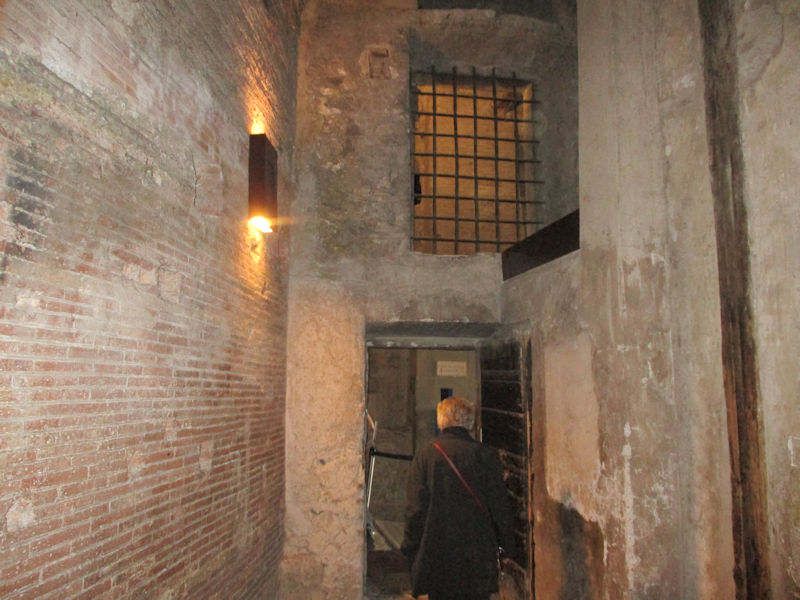
At the top of the ramp, near what was originally the top of the cylinder with a roof garden. The Emperor Hadrian (r. 117-138) commissioned it in AD 135 as a mausoleum for himself and his family; he died before it was completed in 139 but both he and several succeeding emperors were placed here until 217.
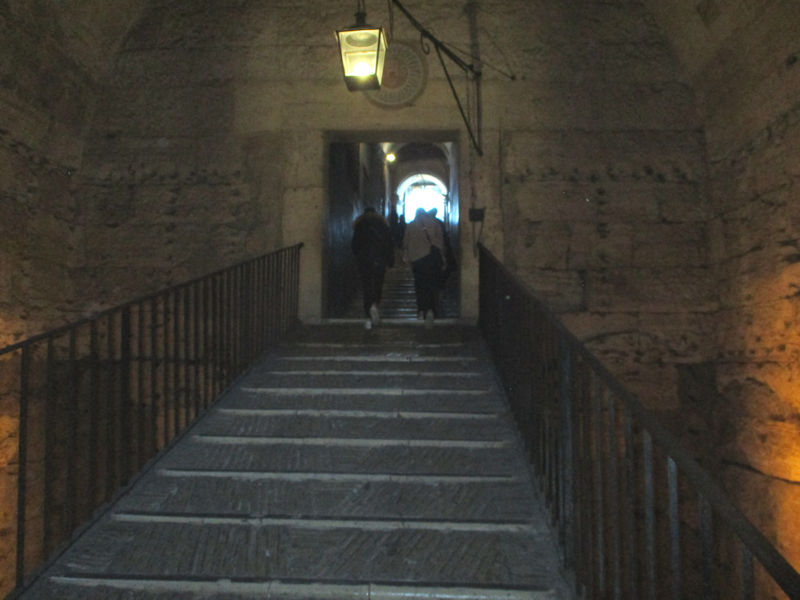
Proceeding across an internal bridge to upper stories that were added by the useless Emperor Honorius (r. 393-423), the younger son of Theodosius I 'the Great', when he ordered up the strengthening and heightening of the city's Aurelian Walls beginning in AD 401, which included transforming the Mausoleum into a fortress.
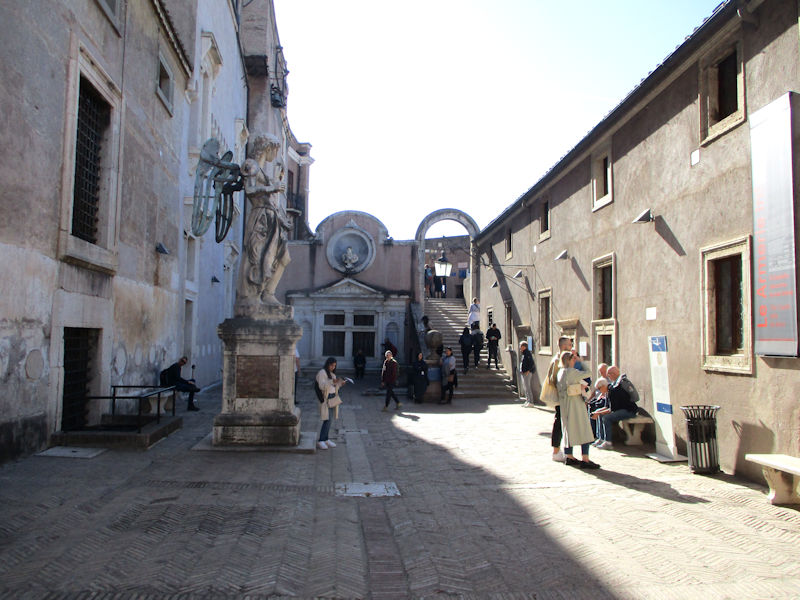
This puts us up into the Courtyard of Honor, part of the papal apartments added in the 15th century. In the background by the stairs to the loggia is the 'aedicule' or chapel niche framed by columns, designed by Michelangelo for Pope Leo X Medici. We note the marble statue of the Archangel Michael (the 'Holy Angel' himself) with his beat-up old bronze wings.
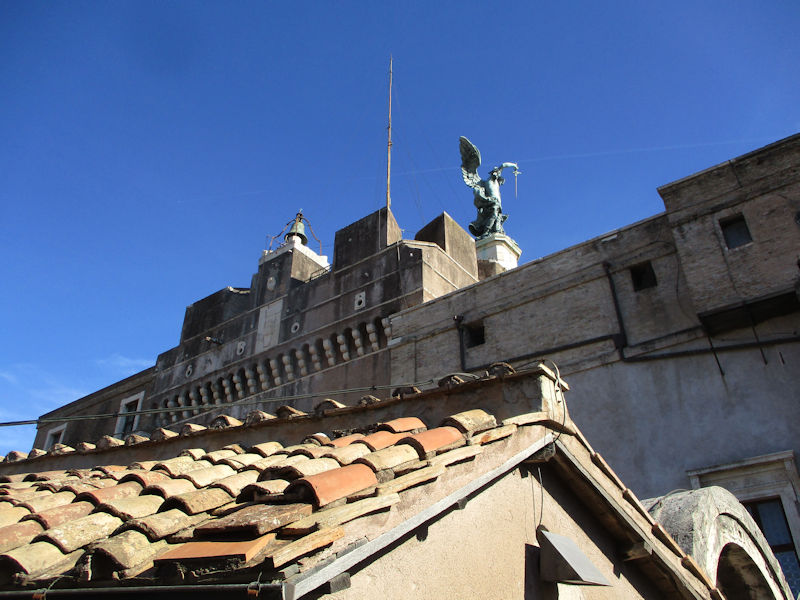
There have been six Angel Michaels up here since Pope Gregory I, the Great, leading a religious procession in 590 to wish away a very long bout of the plague that God had handed down for the Romans' sins, had a vision of the 'Warrior Angel', Archangel Michael, sheathing his sword (as above), which was interpreted to indicate that God was ready to give it over, and the plague duly ended. The first angel was put up here in the 13th century but didn't last; the third one, of marble and bronze, got hit by lightning in 1497, and its replacement had to be melted down to make cannons during the siege of Rome in 1527.
That one was replaced in 1536, and that's the one in the Courtyard of Honor just above, but it was replaced in turn by a new one in 1753, made by a Flemish sculptor, apparently influenced by a 1635 painting by Guido Reni of Michael ferociously hacking away at Satan with his sword.
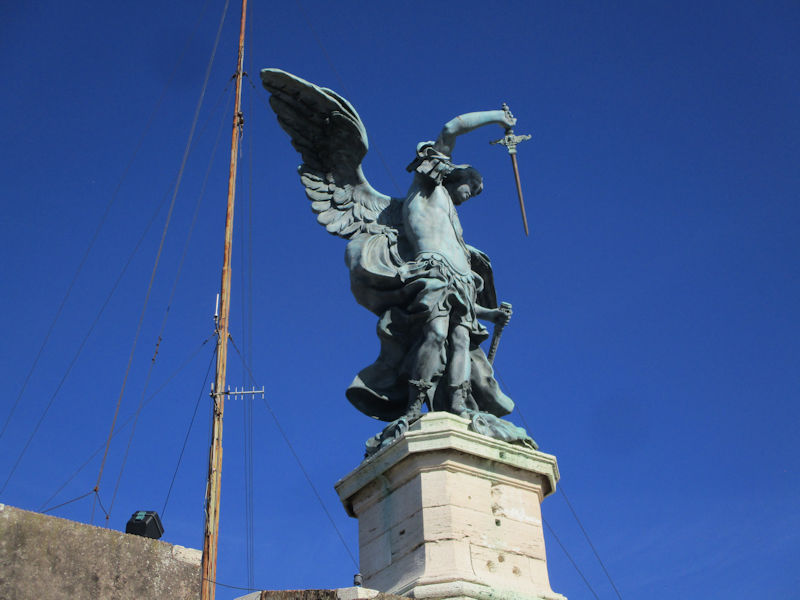
And so the present iteration, by the Fleming von Verschaffelt, is felt to be much more moving than the more elegant but genteel, and faded, one by Michelangelo's apprentice Raffaello da Montelupo now in the courtyard.
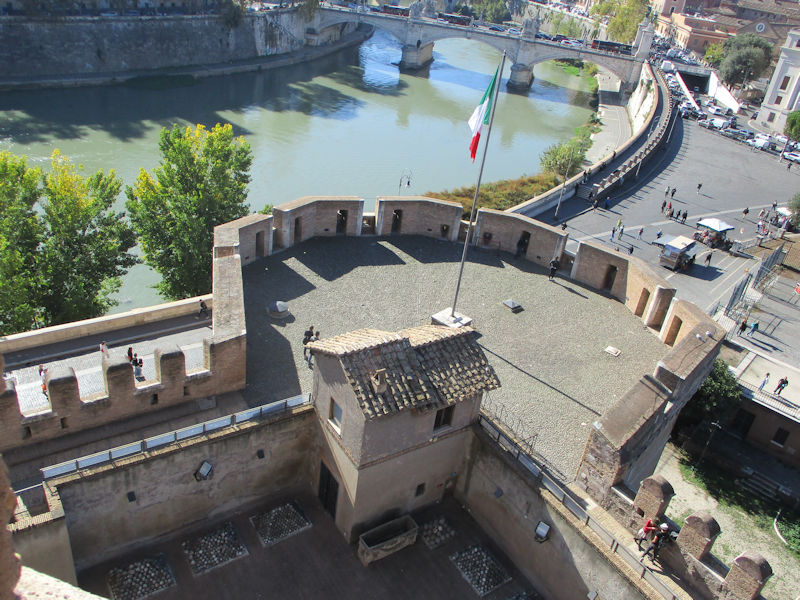
Up the stairs in the courtyard above, we're onto the loggia added to the papal apartments by Pope Paul III Farnese (r. 1534- 1549) in the 1540s, turning the place from a dedicated fortress with Alexander's artillery bastions at the corners into a noble residence as well.
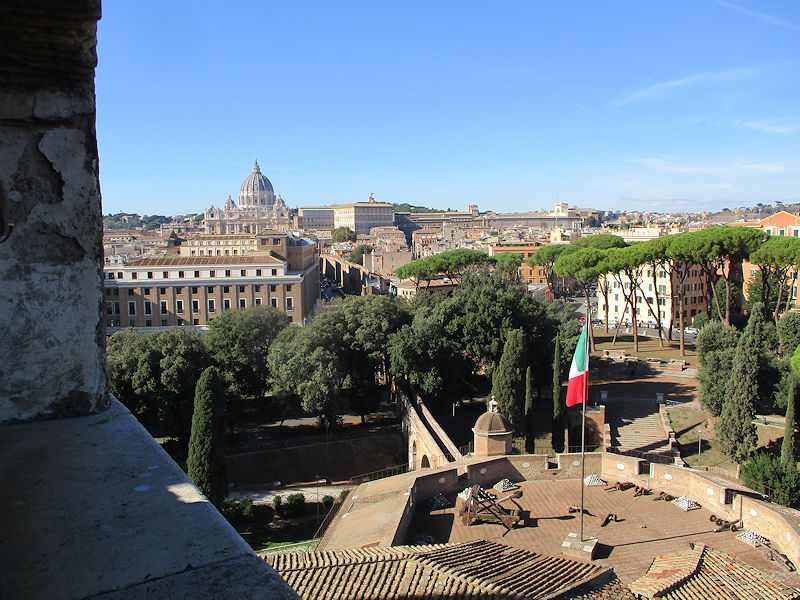
The view from the loggia towards the Vatican and a display of period artillery on the bastion below. The Passetto di Borgo, leading to the Vatican, is open to the sky at this and the other end but otherwise covered for most of the way.
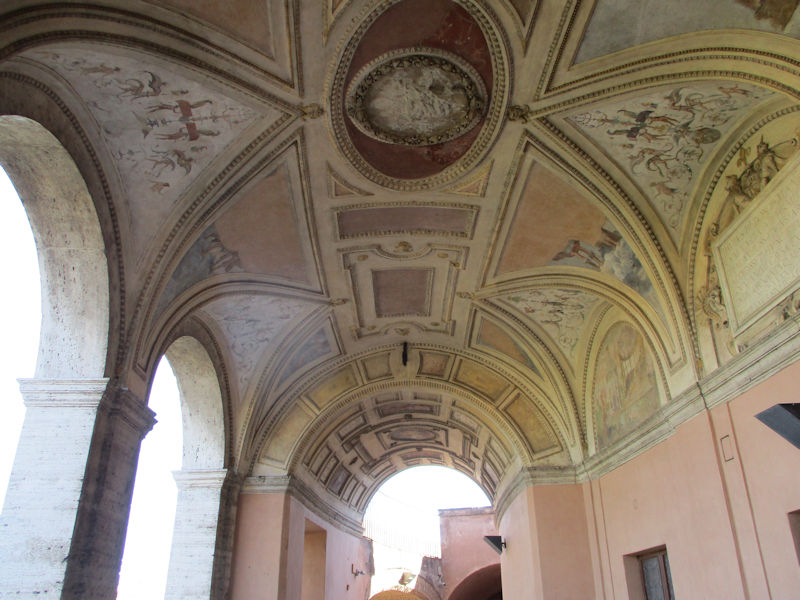
Pope Paul III's loggia leading to the new papal apartments, built in 1543
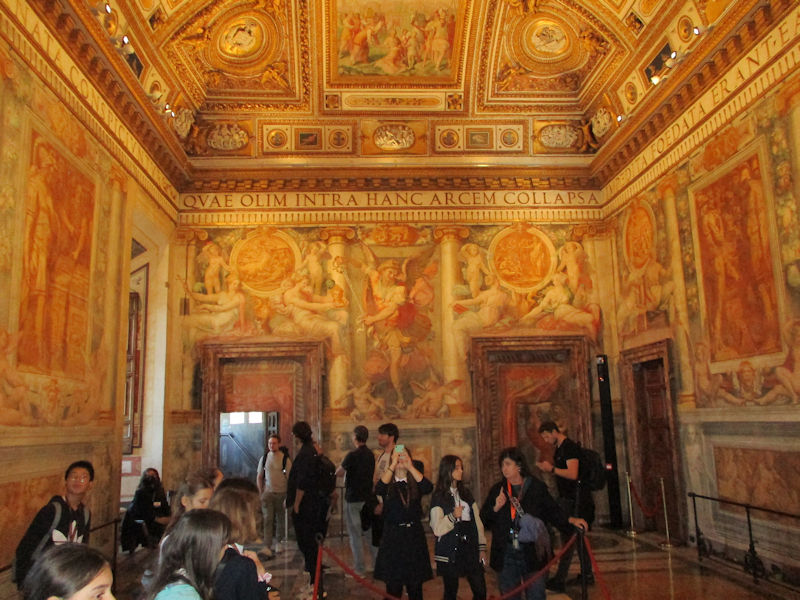
This is described on the info plaques as the 'Paolina Room', where the Pope welcomed and entertained guests; decorated in 1545-47, the long walls have scenes from Alexander the Great's life (Pope Paul's own name was Alexander Farnese), and the short walls have scenes from St Paul's (he'd chosen the papal name Paul).
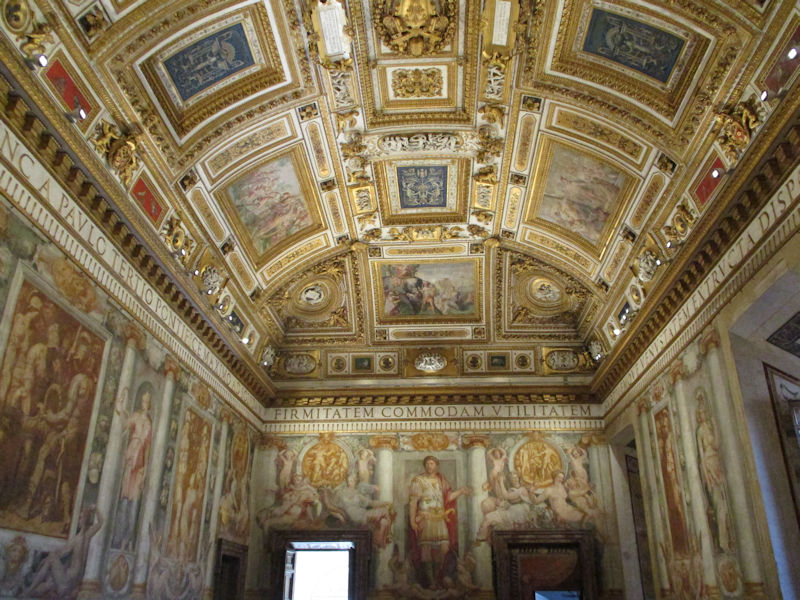
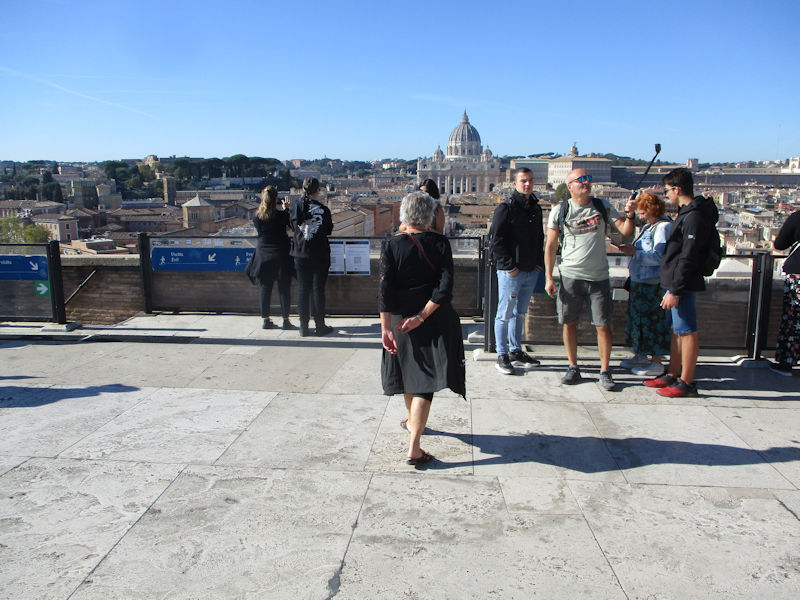
To the rooftop terrace

A view of the Vatican district, with an unroofed portion of the loggia just below
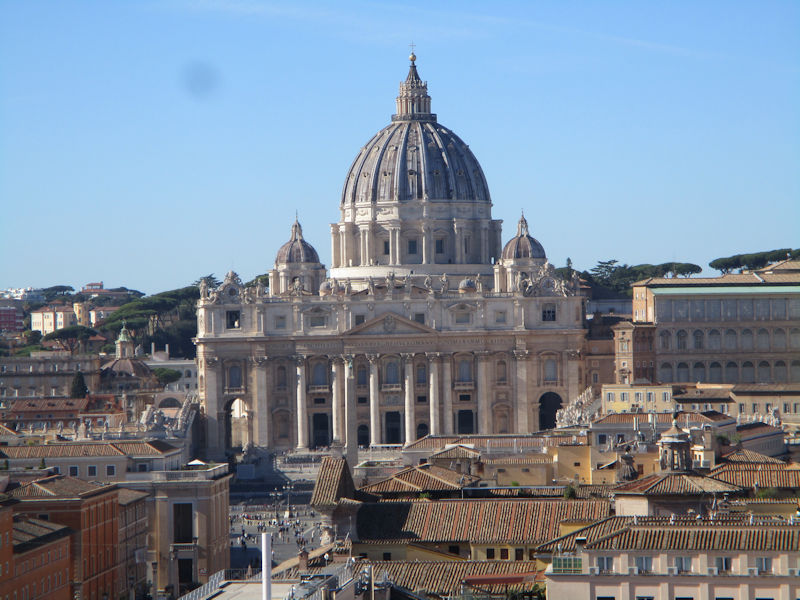
The Basilica of St Peter zoomed
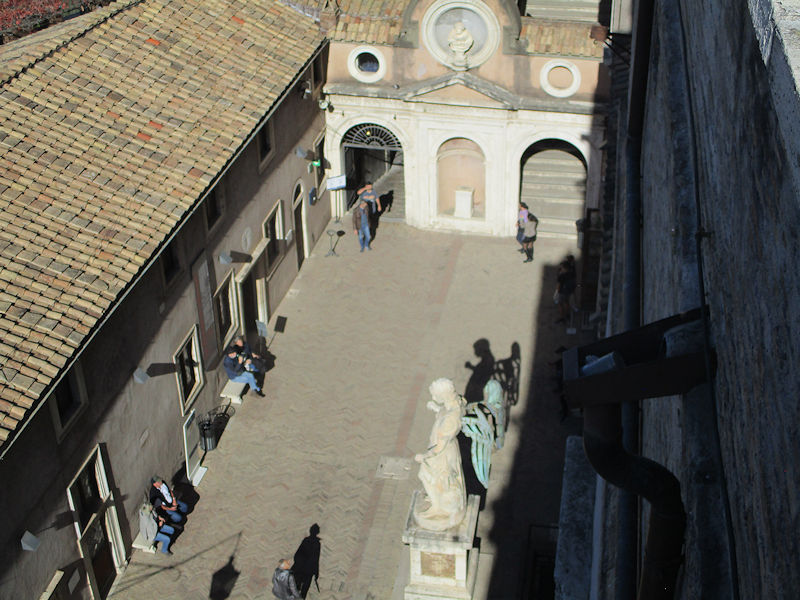
A glance down into the Courtyard of Honor

The northwestern bastion and Passetto di Borgo seen from the loggia
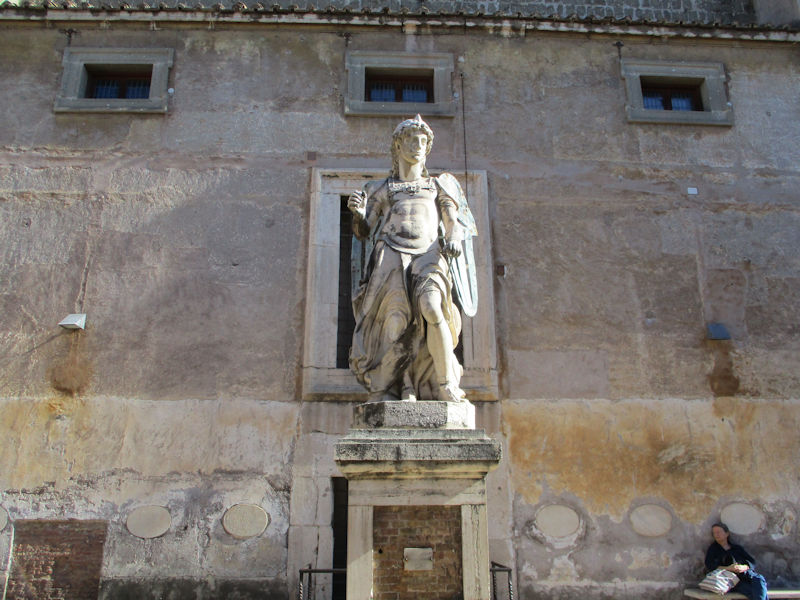
A last look at Montelupo's uninspiring Michael
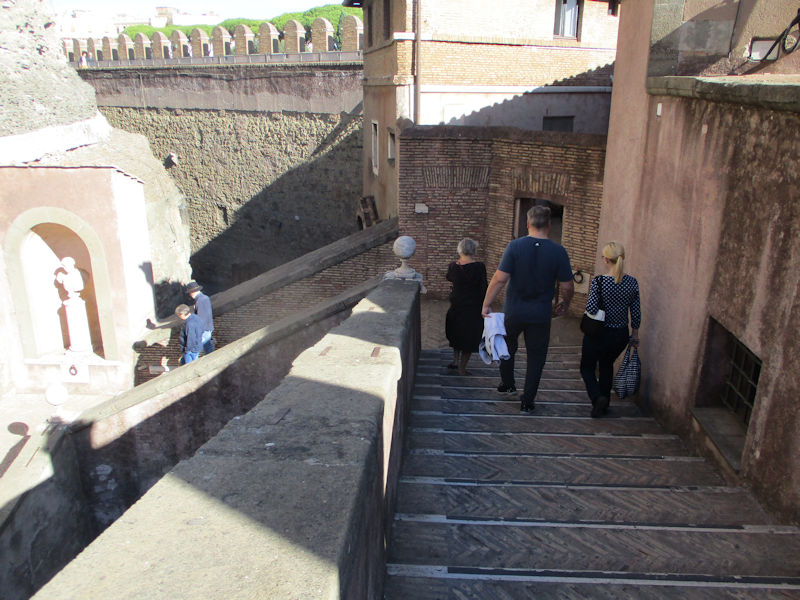
Following a quick wall-walk out by the bastion with the artillery pieces, we're on our way out. Descending that spiral ramp to ground level is something that aging knees should never be subjected to.
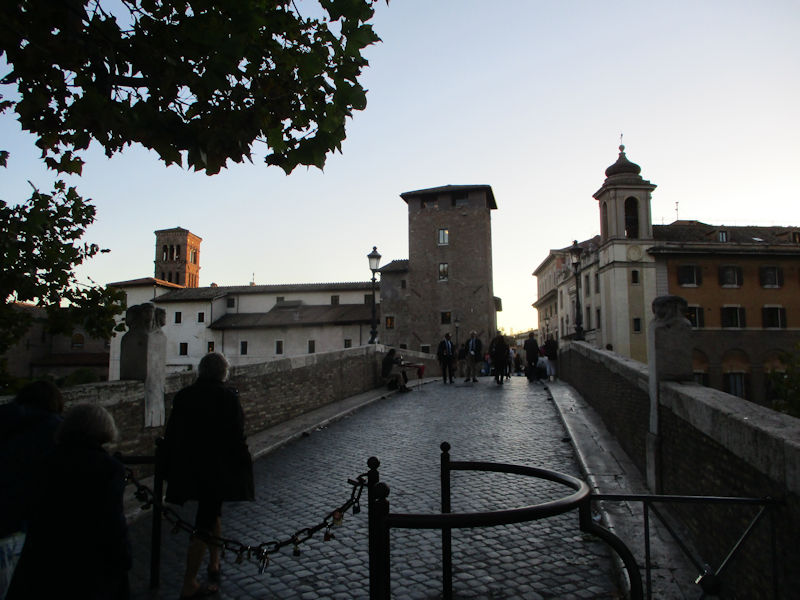
We're looking in at the Tiber Island, crossing the Ponte Fabricio, built in 62 BC and the oldest bridge still in its original condition.
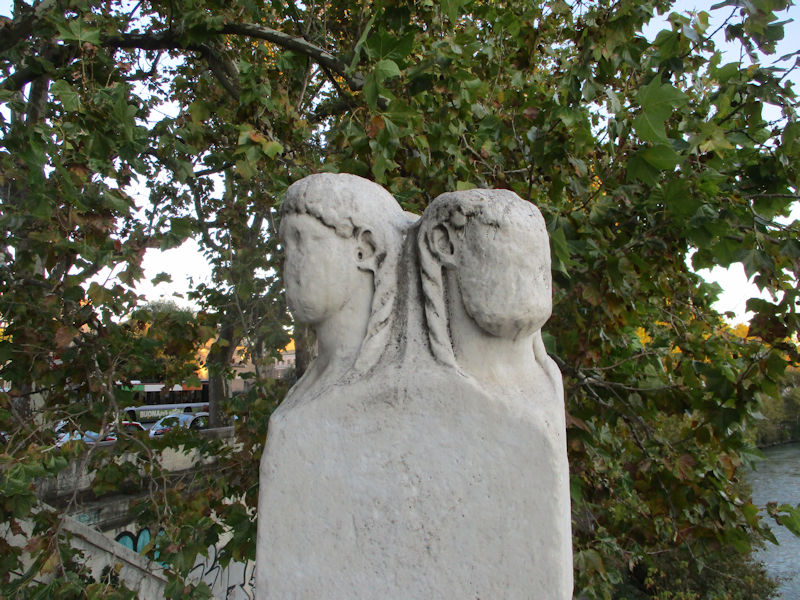
We've all known days like that.
(That's a Janus, by the way; there are two of these here on the parapet, and the bridge is also called the Ponte Quattro Capi, 'of the four heads'.)
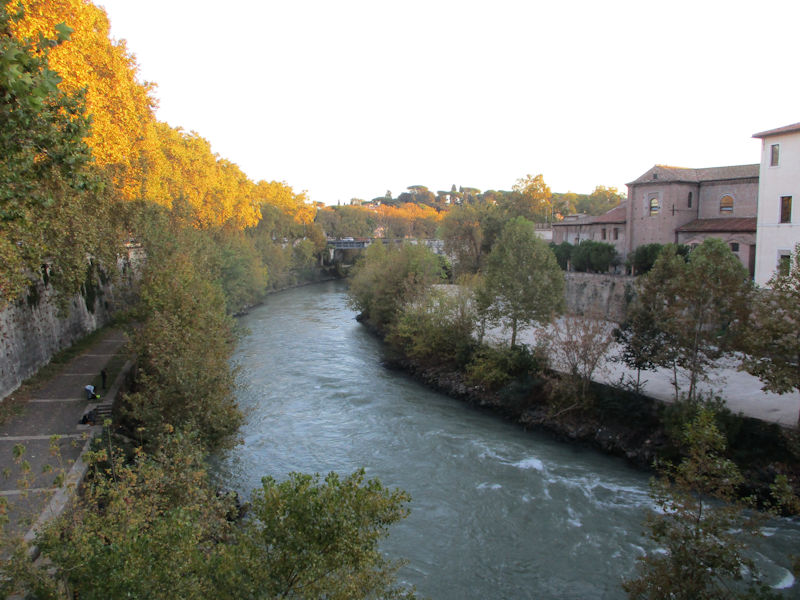
The left bank of the Tiber from the bridge
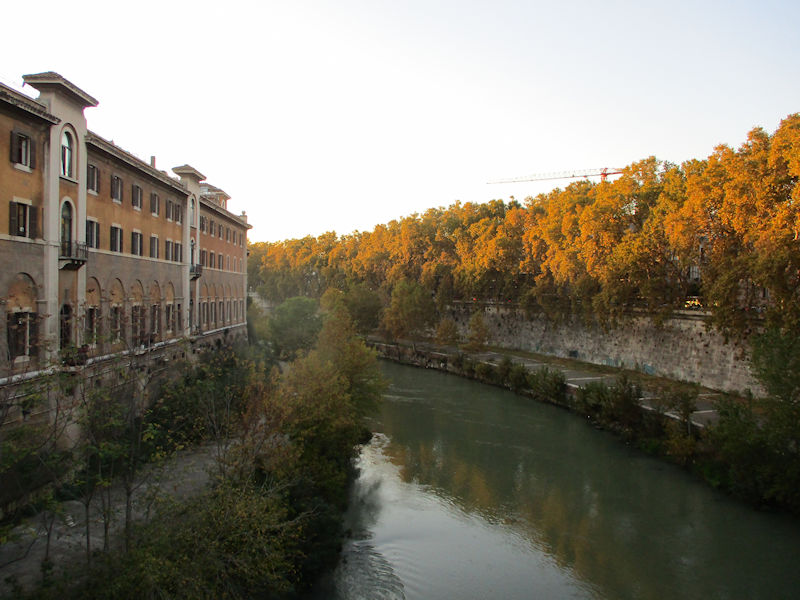
The hospital Fatebenefratelli Isola Tiberina stretches away to the right, behind the Chiesa di San Giovanni Calibita associated with the hospital, all the way to the far end of the island.
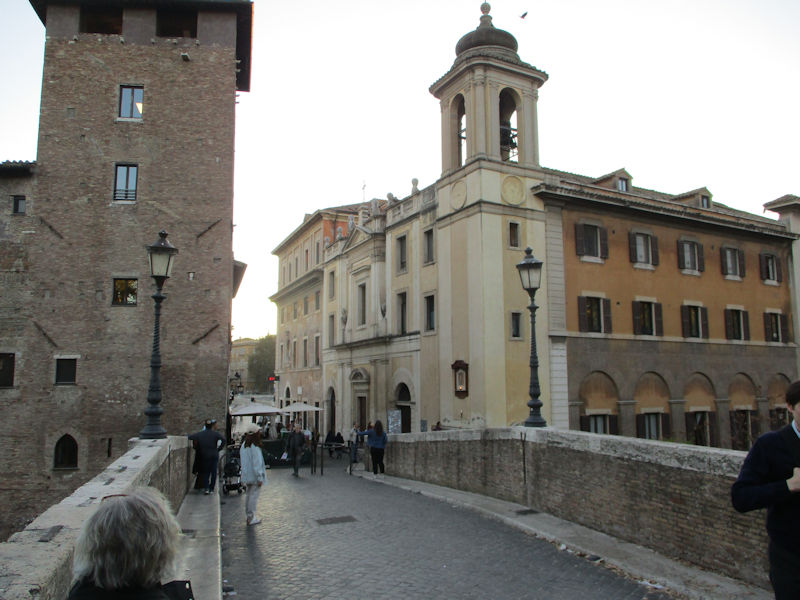
The Chiesa di San Giovanni Calibita façade on the right, and on the left there is, behind a couple of restaurants, an urgent care polyclinic apparently part of the Network Ospedale Israelitico in Rome.
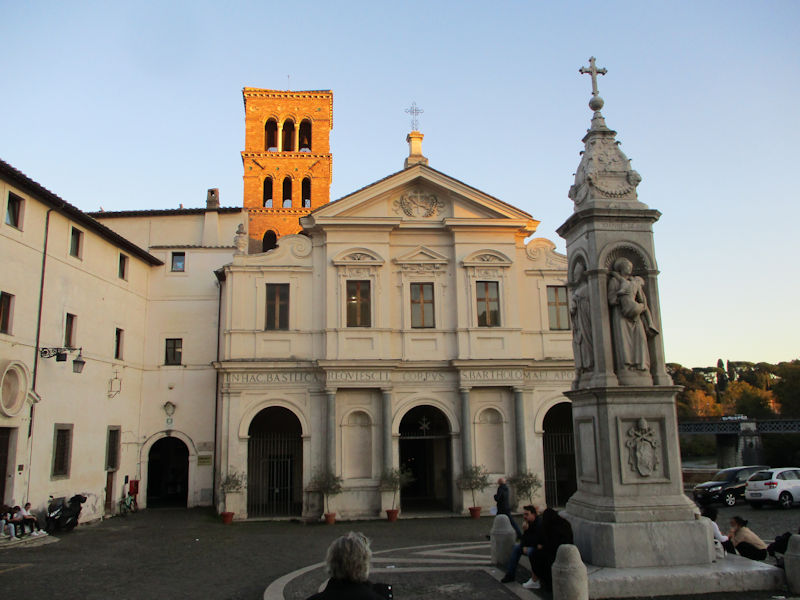
And next to the polyclinic there is the Basilica di San Bartolomeo all'Isola, sponsored by the Community of Sant'Egido since 1993 and dedicated to the 'witnesses of faith', martyrs in effect, of the 20th and 21st centuries.
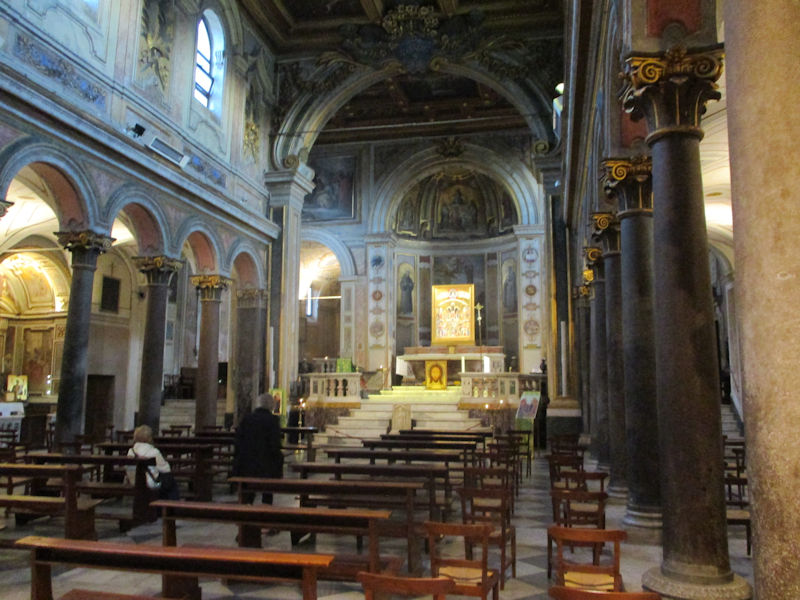
The church itself was founded by the Emperor Otto III in 998, renovated and rededicated to the Apostle Bartholomew when that saint's relics, supposedly found in Armenia in 809, were placed in this church in the late 12th century. The building was damaged in a flood in 1557 and reconstructed with its Baroque façade in 1624.

So guess who's in that old Roman porphyry bathtub under the main altar (full marks for 'St Bartholomew').
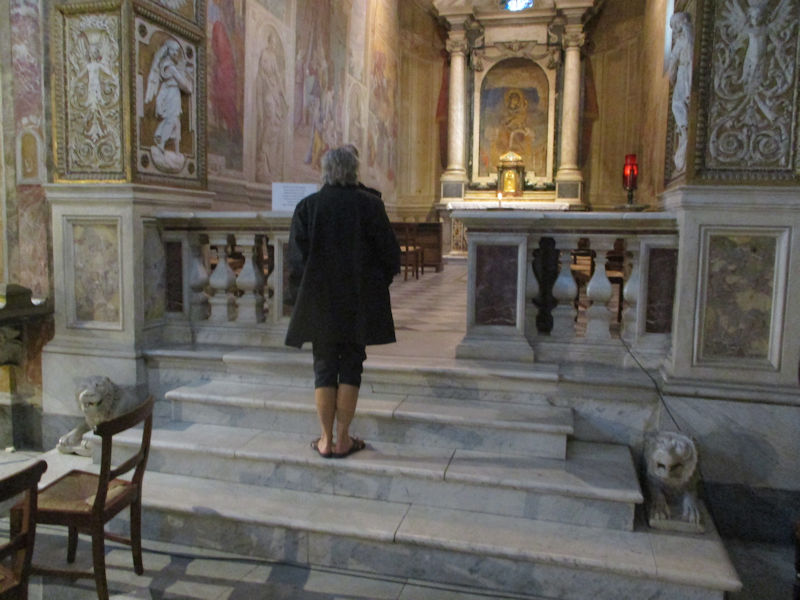
The memorial to 20th & 21st century martyrs was dedicated by John Paul II in 2000.

This represents a small contribution to our collection of photos of Kristin with her hand in the mouths of Italian lions.
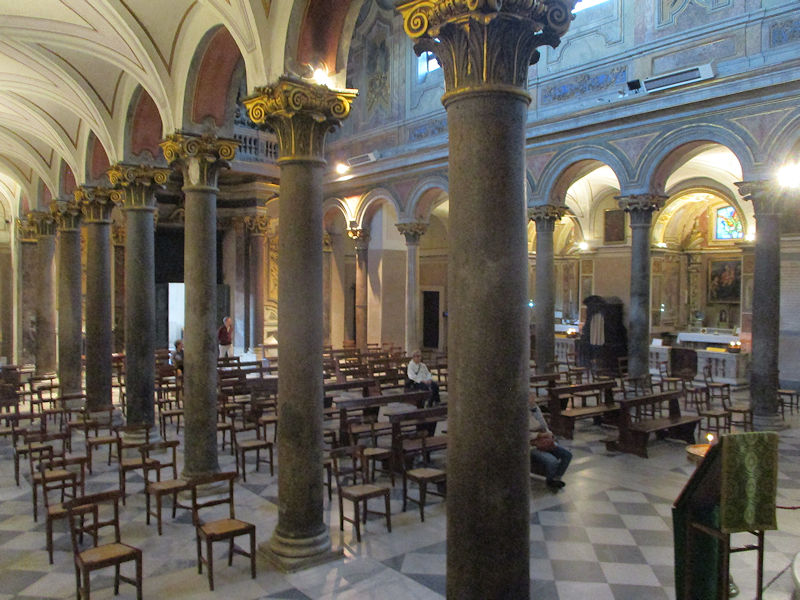
There are said to be fourteen original Roman columns stuck up in here.

An elegant pharmacy across the piazza
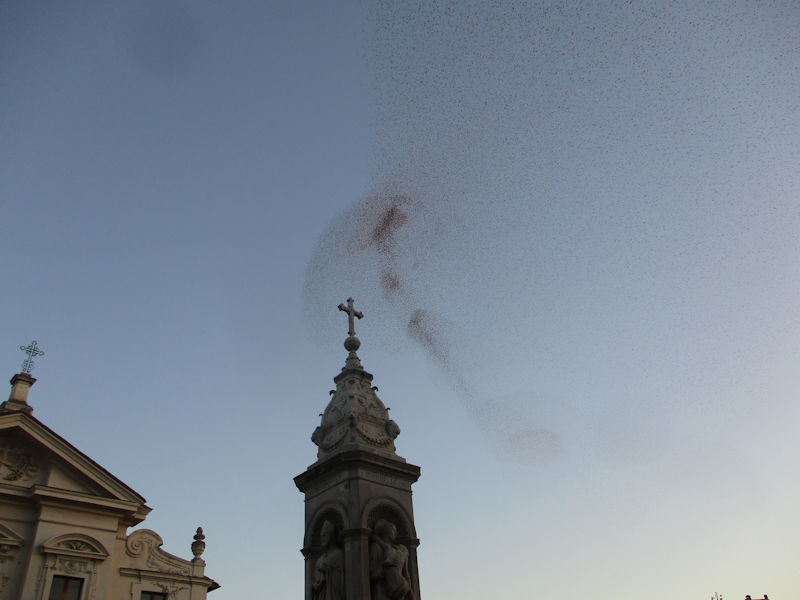
A huge troupe of starlings are putting on a show for us right here over the Piazza San Bartolomeo.
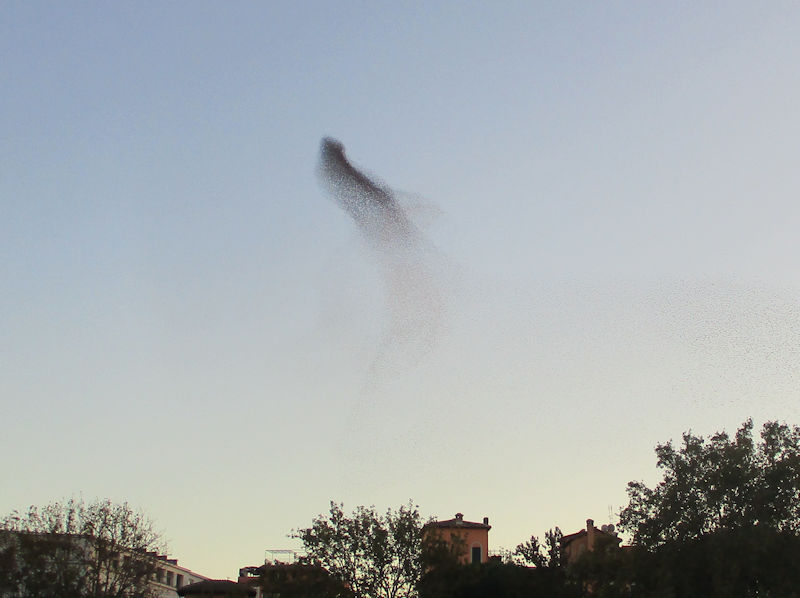
How do they do that?!? And why?
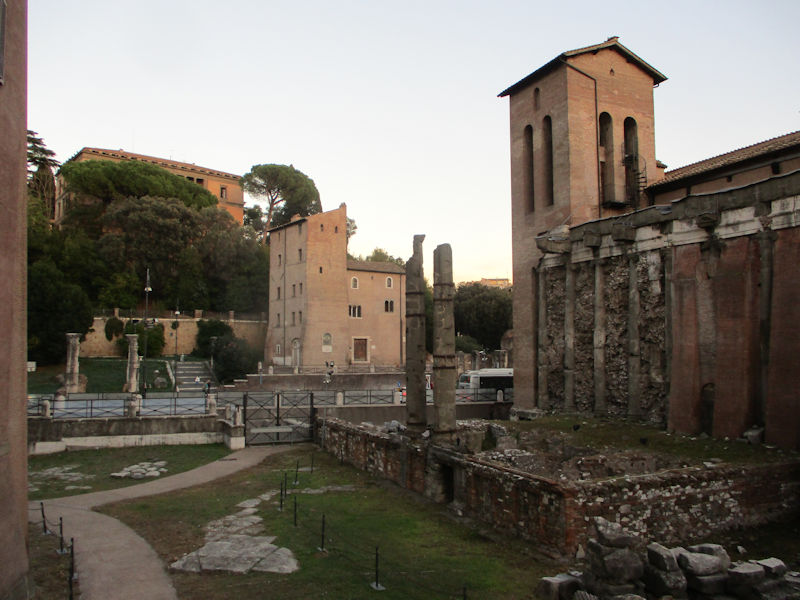
Just back across the Ponte Fabricio, this is the neighborhood of the Teatro di Marcellus, adjacent to the old Ghetto.
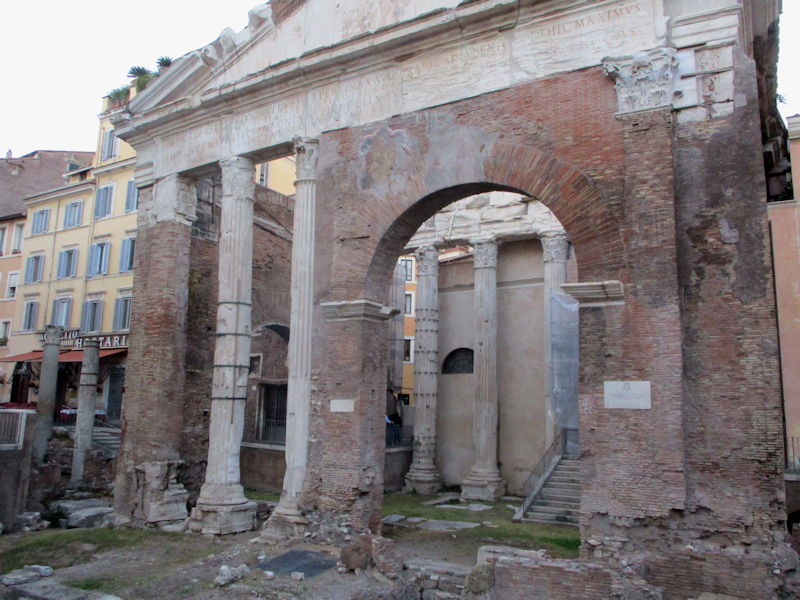
First, the Portico of Octavia, first built to celebrate a triumph in 146 BC to enclose temples to Juno and Jupiter, but rebuilt by Augustus Caesar in 27-23 BC and dedicated to his sister Octavia. Most of what remains reflects a later restoration by the Emperor Septimius Severus in AD 203.

The path round the Theatre of Marcellus
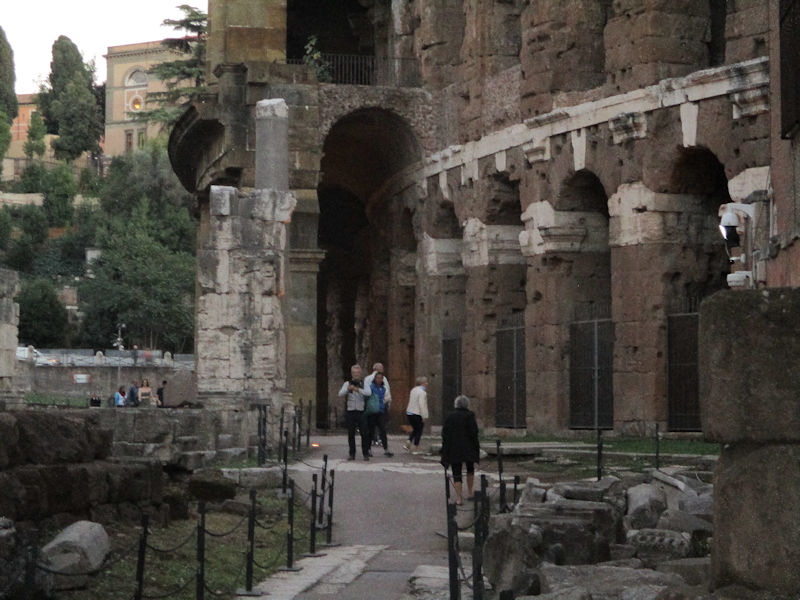
The enormous open-air theatre, the most important one in ancient Rome and capable of seating nearly 18,000 people, was planned by Julius Caesar but not completed until 13-12 BC by Augustus and named for his nephew, who'd died in 23 BC.
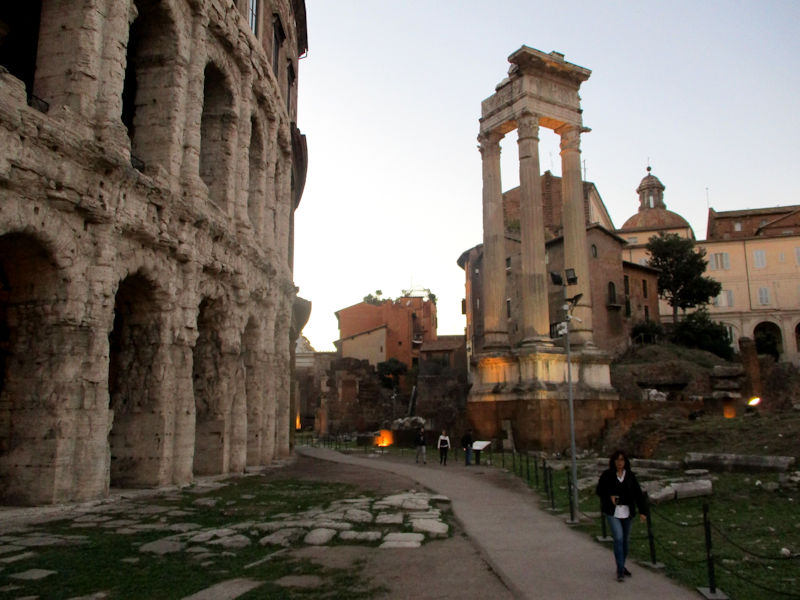
It fell out of use in the 4th century and was used as a quarry for a time, and then as a fortress by a succession of competing urban families.
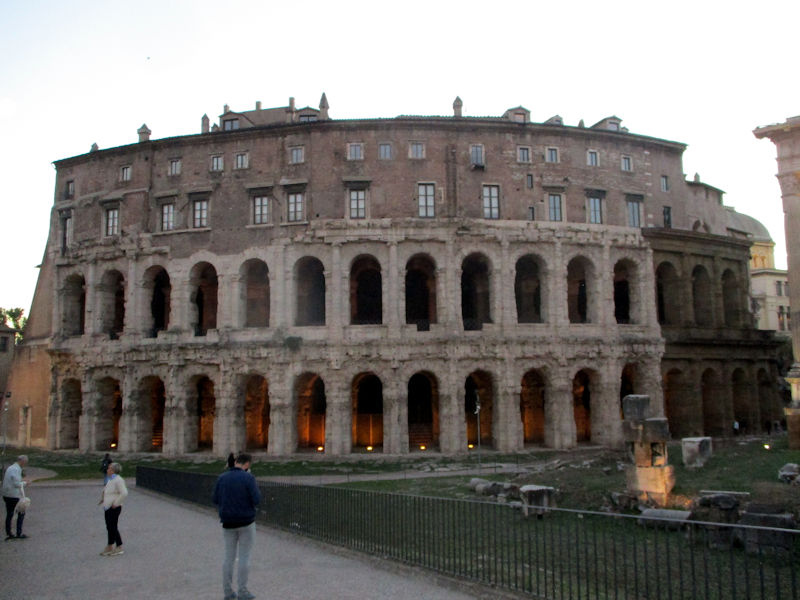
In the 16th century, the Orsini clan built one of their residences over the top of the ruins, and apartments are still in use up there. The grounds here in front of it are still used for concerts and whatnot.
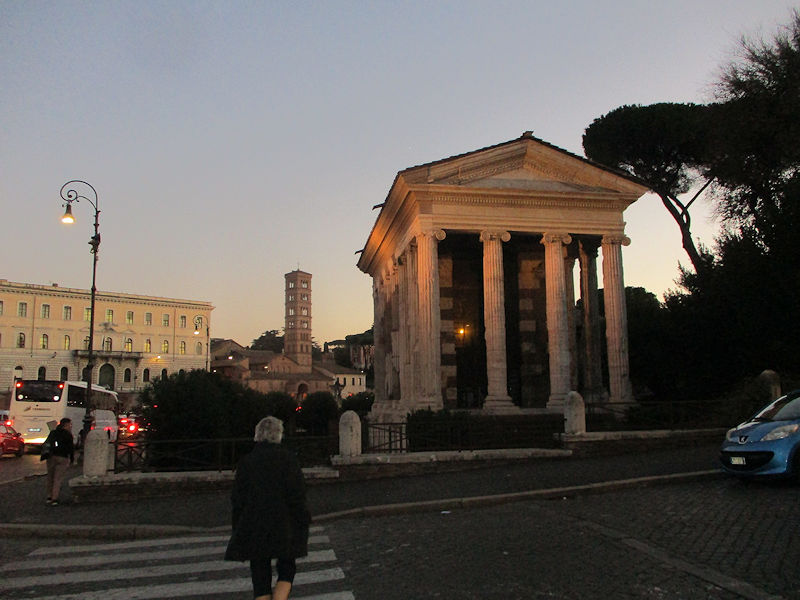
As we continue at dusk, we're shuffling past the Temple of Portunus, aka the Temple of Fortuna Virilis -- it dates from the 3rd or 4th century BC, rebuilt in 120-80 BC, placed here keep an eye on the cattle barges coming up the river to the Tiberinus Port at the bend of the river here (Portunus was the god of livestock, amongst other jobs). The temple is in fine shape because the Christians adopted it in the 9th century for St Mary of Egypt.

And here is the Church of St Maria in Cosmedin, which was founded in the 6th century, and this building was built in the 8th, all during the period of the post-Justinian 'Byzantine Papacy' in Rome (AD 537-752), when the Byzantine Emperors were approving the election of Roman popes and there was a thriving Greek community in Rome ('Cosmedin' is a corruption of a Greek word for 'ornamentation', as made by Greek monks fleeing from the iconoclasm persecutions of the 8th and 9th centuries).
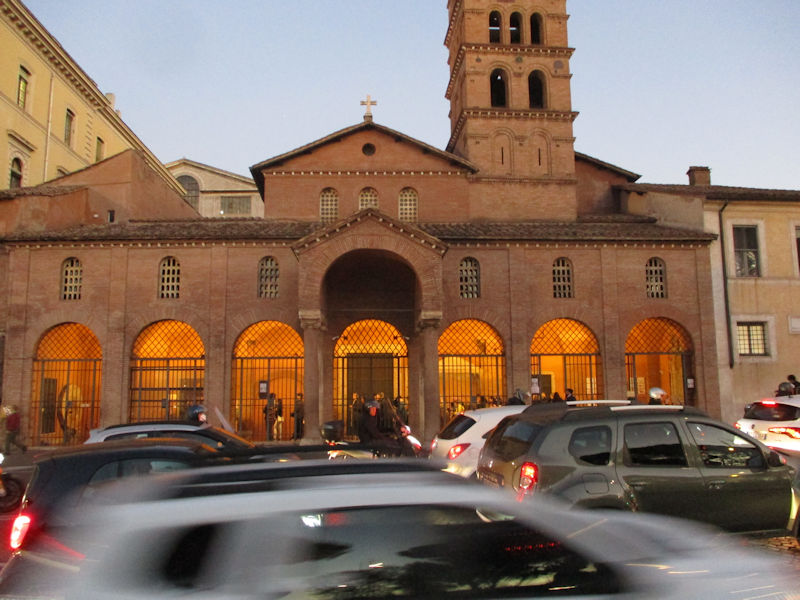
Those folks are all lined up to take their turns at sticking their hands into the Bocca della Verità, the 'Mouth of Truth', evidently an ancient manhole cover, there on the left side of the portico. From a medieval legend, the ton-and-a-half marble mask bites off the hand of any liars who are dumb enough to stick their hands in it, or who tell a lie when their hands are in it. In Roman Holiday (1953), Gregory Peck tries to convince Audrey Hepburn that he's got his hand stuck in it.
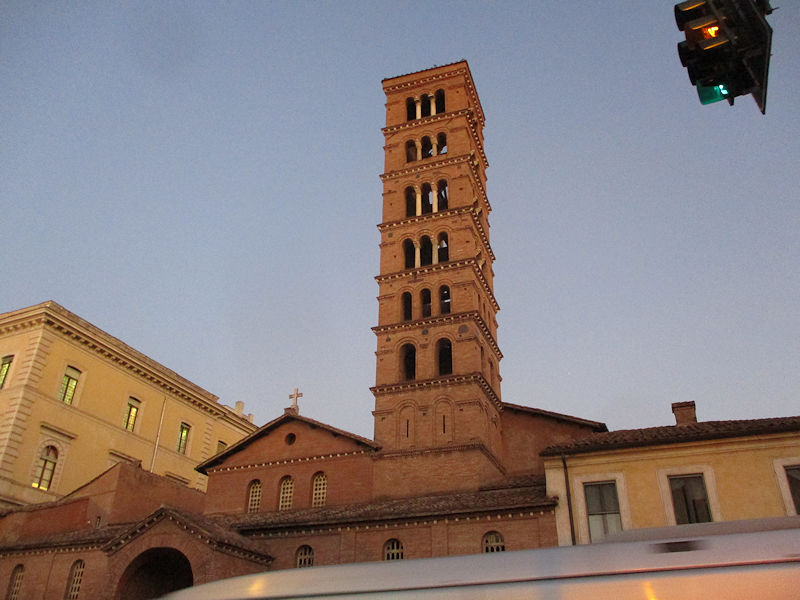
We, on the other hand, are not thoughtless enough to risk that fate, and we'll go in and view the church itself. That, by the way, is the tallest bell tower in Rome.
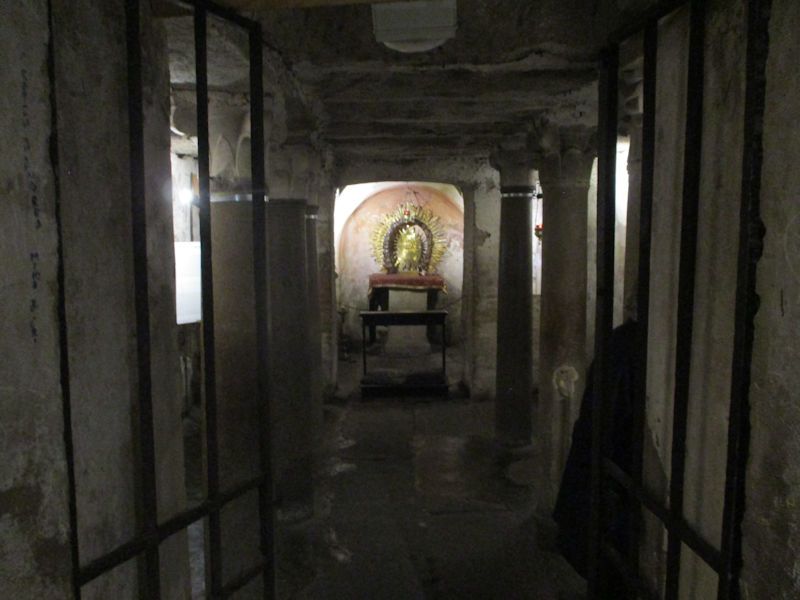
This is the crypt of Pope Adrian I from the 8th century, and . . .
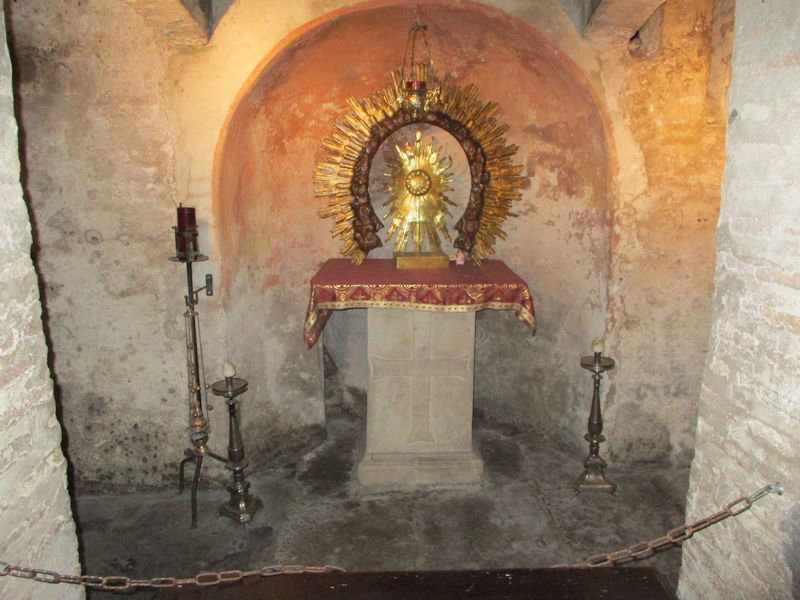
. . . we're told that it was built to hold the relics retrieved by Adrian from the Roman catacombs.
Next up: The Archbasilica of St John Lateran, and the Holy Stairs

       
 Feedback
and suggestions are welcome if positive, resented if negative, Feedback
and suggestions are welcome if positive, resented if negative,  .
All rights reserved, all wrongs avenged. Posted 18 December 2022. .
All rights reserved, all wrongs avenged. Posted 18 December 2022.
|
 Dwight Peck's personal website
Dwight Peck's personal website































































































